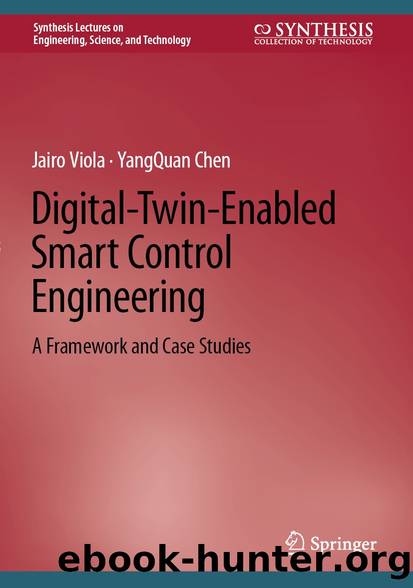Digital-Twin-Enabled Smart Control Engineering by Jairo Viola & YangQuan Chen

Author:Jairo Viola & YangQuan Chen
Language: eng
Format: epub
ISBN: 9783031221408
Publisher: Springer International Publishing
3.3 Control Performance Assessment
Control performance assessment is for measuring the control quality of a closed-loop system against different control methodologies [8]. In control engineering, it is a mandatory task for control system design in order to reach the desired and optimal response of the system to be controlled. The implementation of control performance assessment requires a closed-loop system operating in a stable condition, a set of important measurements from the system collected by sensing devices, a processing methodology that includes a set of Key Performance Indices (KPI), and software tools to performing control performance assessment analysis. As an example, a standard Single-Input, Single-Output (SISO) control system block diagram is presented in Fig. 3.2. It is composed of the plant or the physical system to be controlled, the controller or control rule for the system, the actuators, and feedback sensors. Likewise, the SISO system incorporates the output signal y(t), desired reference r(t), error signal e(t), control action u(t), and the disturbance signals d(t) and z(t) for the control action and system output, respectively.
Based on the signals in Fig. 3.2, the control performance assessment can be performed, calculating some of the key performance indices [8]. A list of the performance indices employed in control engineering can be found in Fig. 3.3. It can be observed that these indices are segmented into step response, data-based, statistical, model-based, and alternative indices. Some of these indices like overshoot, settling time, mean or standard deviation, integral square error (ISE), and minimum variance are commonly employed for control performance assessment, assuming a Gaussian behavior of the sampled signals. Thus, the effect of aggressive or soft control actions, feedback sensor failure, or the presence of disturbances in the control loop can be quantified to determine how much it deviates from its desired behavior. In the context of Industry 4.0, not only the disturbance behavior but also the signals of the closed-loop system may behave following non-Gaussian probability distributions due to the environmental variability and the systemâs interconnected features. In this case, CPA requires alternative performance indices like the -stable distributions, fractals, and system entropy [9].
Fig. 3.3CPA key performance indices (KPI)
Download
This site does not store any files on its server. We only index and link to content provided by other sites. Please contact the content providers to delete copyright contents if any and email us, we'll remove relevant links or contents immediately.
Whiskies Galore by Ian Buxton(41529)
Introduction to Aircraft Design (Cambridge Aerospace Series) by John P. Fielding(32888)
Small Unmanned Fixed-wing Aircraft Design by Andrew J. Keane Andras Sobester James P. Scanlan & András Sóbester & James P. Scanlan(32573)
Aircraft Design of WWII: A Sketchbook by Lockheed Aircraft Corporation(32134)
Craft Beer for the Homebrewer by Michael Agnew(17933)
Turbulence by E. J. Noyes(7700)
The Complete Stick Figure Physics Tutorials by Allen Sarah(7137)
The Institute by Stephen King(6802)
Kaplan MCAT General Chemistry Review by Kaplan(6595)
The Thirst by Nesbo Jo(6435)
Bad Blood by John Carreyrou(6274)
Modelling of Convective Heat and Mass Transfer in Rotating Flows by Igor V. Shevchuk(6222)
Learning SQL by Alan Beaulieu(6035)
Weapons of Math Destruction by Cathy O'Neil(5829)
Man-made Catastrophes and Risk Information Concealment by Dmitry Chernov & Didier Sornette(5646)
Permanent Record by Edward Snowden(5537)
Digital Minimalism by Cal Newport;(5389)
Life 3.0: Being Human in the Age of Artificial Intelligence by Tegmark Max(5184)
iGen by Jean M. Twenge(5161)
